tl;dr: Buy a step-up ring of appropriate size for your lens, buy a solar filter sheet, paste the sheet into the ring, screw the ring on your lens. And practice before the solar eclipse on August 21!
See my full post with the final result here: Photographing the 2017 Total Solar Eclipse.
On August 21, 2017, North America will experience a Total Solar Eclipse, and for the photographers among us, it will be an exciting opportunity to photograph a rare astronomical event! I started my own preparations a few months ago, making sure I had a good spot for the event (I'm lucky to live in the path of totality), resources to help practice for the event, and the equipment I need to prevent damage to both my own eyes and my camera sensor (the sun is extremely bright, and will cause damage to the unprotected eye or sensor).
There are many different parts of the eclipse that are interesting, and all happen within the course of a few minutes. Since you will have little time to fiddle with camera settings, make adjustments, or change gear on your camera(s), it's imperative you prepare early.
To that end, one of the most important things you'll need is a solar filter. Some photographers use ND ('Neutral Density') filters to reduce the amount of light getting to the lens... but the sun is orders of magnitude brighter than most objects which reflect the sun's light, and solar filters reduce the light transmission to about 1/1000th of 1%—so only 0.00001% of light makes it through the filter!
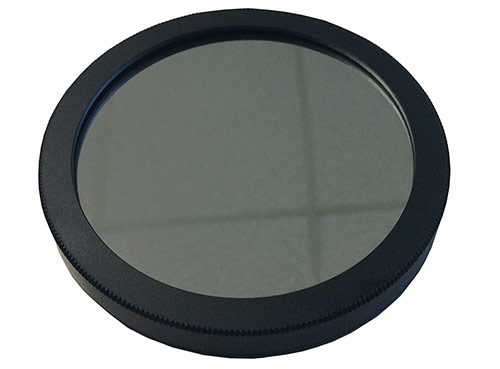
One of the many expensive threaded filter options on Amazon.
Once you realize you need a solar filter, you may check prices of standard screw-on solar filters, and realize how expensive astro/solar photography can be! I was searching for a cheap filter since I'll only use it a few times, and don't need something rugged and durable... but the prices started around $100 for smaller diameters and went up from there!
After thinking through the problem, I found a way to make my own solar filter (with threads so I can screw it in place on the front of my lenses) for less than $30, and I'm documenting it here in case others want to do the same thing.
Required parts
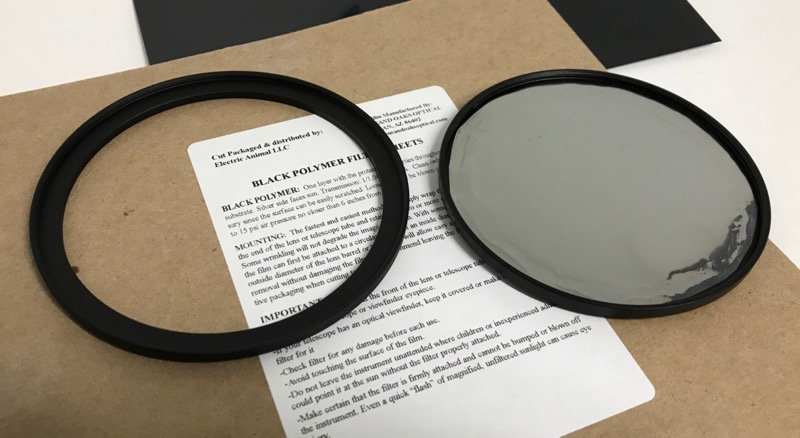
- 77mm to 95mm step-up ring adapter (get a base size appropriate for your lens, e.g. 77mm for my Nikon 70-200 VR, or 95mm for a Nikon 200-500 VR)
- 8" x 8" Solar Filter sheet for cameras, telescopes, and binoculars
- Super Glue
I already had some super glue on hand (I always have a dozen or so of the one-time-use variety on hand because it's super handy for fixing all kinds of things).
Assembly
The most important thing to keep in mind is that inexpensive solar filter sheets are inexpensive mostly because they're not as rugged as the glass filters that cost a lot more. Because of this, you need to be careful handling the filter. In the case of the sheet linked above, the actual filter sheet comes in a protective cardboard sleeve, and has explicit instructions to handle it carefully, since it scratches very easily.
Each side of the sheet has a very thin metallic coating, and even touching it gently with your finger can be enough to leave a mark! So, to get the filter mounted on the threaded adapter:
- Roughly measure the diameter of the step-up ring adapter you bought, and cut a square out of the solar filter sheet about that size (use the included latex glove to handle the sheet, so you don't damage the rest of the sheet while you cut out the section you need!).
- Hold the square cutout over the step-up ring and slowly trim away bits until the sheet fits nicely inside the ring (with overlap so you can glue it down).
- Put a very light amount of super glue around the ring, and gently press the cut-to-size filter sheet into the bed of glue, with the mirror side facing away from the camera (so the sun can see it's own reflection ?).
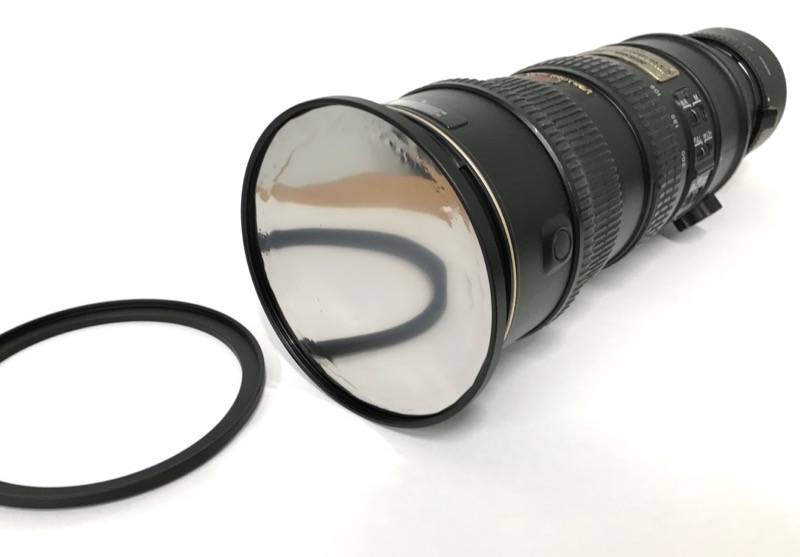
Bingo! DIY solar filter that screws right into the front of your lens!
Testing
If you plan on taking pictures of the actual eclipse, it's best if you practice timing and technique as early as you can—especially if you've never taken pictures of the sun before. And a strong word of warning: never take a picture of the sun without a solar filter in place! The one exception is during totality (assuming you're in the path of totality)—for that brief period, you can pop off the solar filter and takes some pictures.
The simplest test (one which I've been doing every few days) is to screw on the filter, walk outside, and take a few shots of the sun. Here's one I took a week ago, when there was a prominent sun spot visible on the surface:
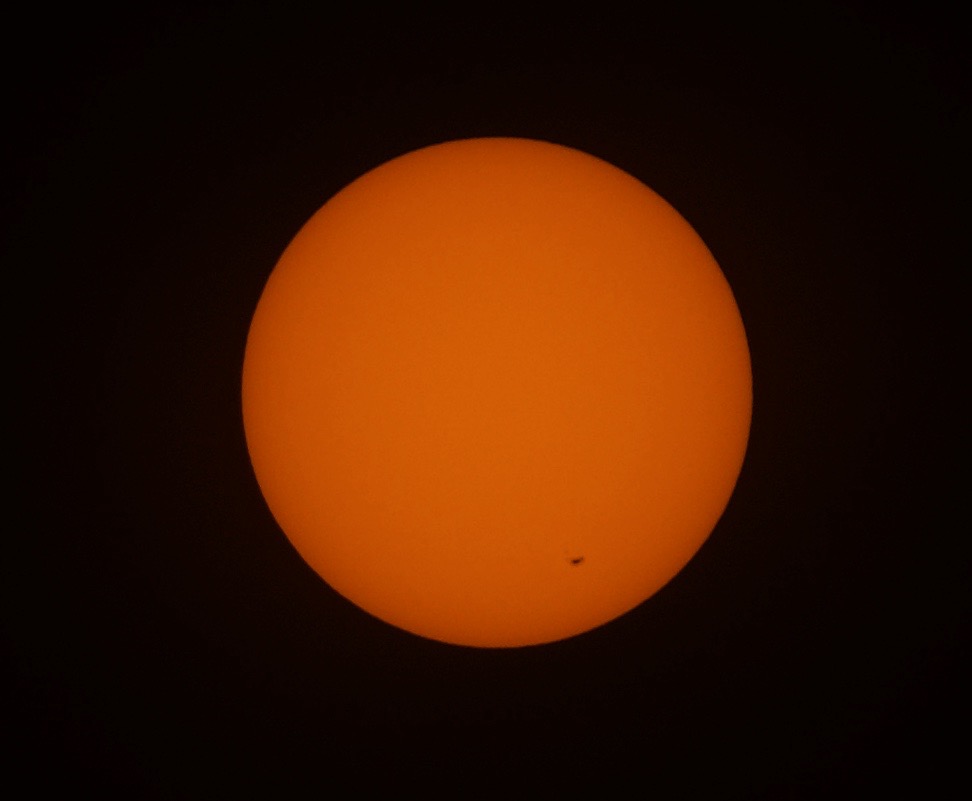
The key is to practice now so you can enjoy and remember the actual event, instead of wasting time and effort switching camera settings and getting bad pictures. Also, make sure to get out from behind the viewfinder and observe the event with your own eyes—it's not just the sun that shows off some beautiful imagery—the environment around you may also change a bit! (I'm planning on having a separate Raspberry Pi set up somewhere else, showing the sky and ground in the frame, and having it record a timelapse with Pi Timelapse!)
Summary
For around $30, you can build your own DIY threaded solar filter for almost any size of lens. Check out these other great resources to learn more about the eclipse:
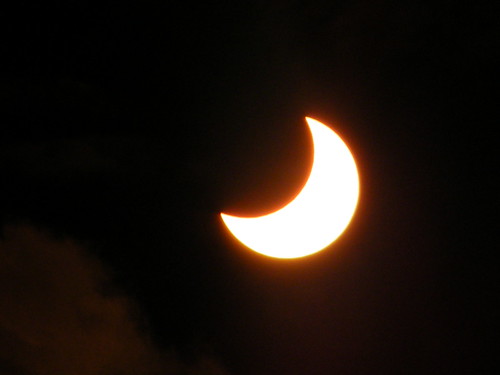
Comments
Couldn't you add a UV filter to the step-up ring and glue the film to the inside of the UV filter? This would protect the mirror side of the film with a glass cover.
That would definitely result in a more polished and durable filter. One risk is the UV filter adds extra glass and without really good lamination or glueing, it could cause another internal reflection and/or glare. I might try it sometime just to see how well it works.
Jeff,
Instead of screw on filters, I would recommend universal slip-on filters. Seconds counter at totality, and I wouldn't won't to be wasting time unscrewing a filter. The slip-on filters listed on this link provide a range of filter sizes that would fit. Under windy conditions, they could be secured on the lens by gaff tape.
https://www.bhphotovideo.com/c/buy/universal-solar-filters/ci/57108
True! I actually just ordered a couple slip-on filters so I can have them more readily adjustable.
It'd be really nice if I could rig up a light magnetized setup as I like having a rigid filter ring (so the filter itself can't flex easily—would potentially warp the final image), but the easy replacement of the slip-on filter.